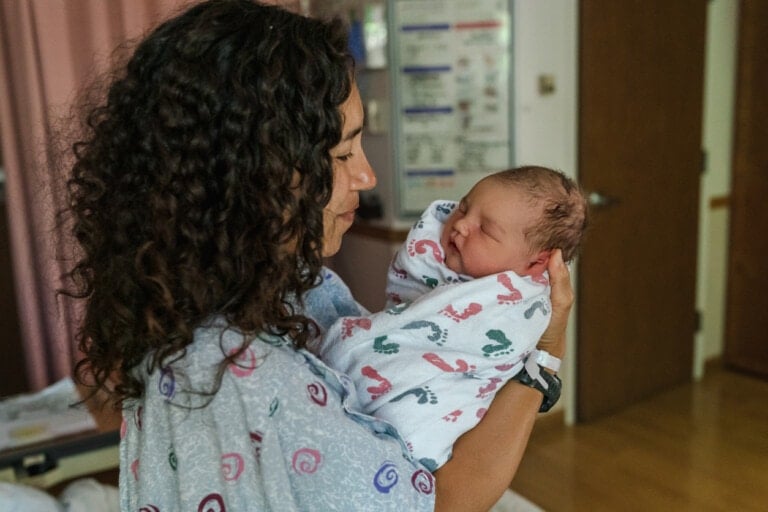Getting pregnant after having a C-section can bring a complicated decision with it: should you have a VBAC (vaginal birth after cesarean) or a repeat cesarean? Deciding to have a VBAC or schedule a cesarean is an intimately personal choice, and many important and individualized factors should be considered when making this decision. The most important things you can do are to get educated about VBAC and repeat C-sections, honor your gut instincts, and find a provider who fully supports your autonomy in that choice.
While some women want a repeat cesarean, others prefer the benefits and experience of vaginal birth. What may be a pro for one parent might be a con for another. Knowing the context of your unique medical history and considering your personal preference will help you make that decision. However, sometimes birth doesn’t go according to plan, and knowing the risks and benefits of both options will prepare you if your plans need to change. In this article, we’ll discuss the risks and benefits of a VBAC and repeat cesarean, why you might choose either, and how to find support, no matter which you choose.
Vaginal Birth After Cesarean (VBAC)
It’s crucial to know that VBAC is a safe and reasonable option for many parents with a prior cesarean. Dr. Jeanna-Marie Guise, MD MPH, states, “I think it’s important to know that VBAC is an option for most women, and their chances of success are quite high,” with the NIH reporting success rates at approximately 74% in 2010.1 Let’s take a closer look at this birth option:
What Are the Benefits of a VBAC?
The obvious benefit of having a VBAC is avoiding another major surgery and the possibility of complications that come with it.3 Vaginal birth typically results in a shorter stay at the hospital.5,6 It makes it easier and quicker to return to your normal daily activities, which is especially important when you have one or more children at home who need you. A VBAC may also be desirable if you want the experience of having a vaginal delivery.6
Another benefit of having a VBAC is the impact that the mode of delivery has on your plans for future pregnancies. Each cesarean brings higher chances of complication.7 Some providers limit a parent to three or four cesareans because of that risk. A vaginal delivery comes with fewer chances of complications and doesn’t limit possible future pregnancies.6
The benefits of a VBAC are in line with the overall benefits of vaginal birth and include:3,6,8,9,10,28
- Less blood loss and reduced risk for hemorrhage
- Decreased chance of baby having breathing issues due to underdeveloped lungs
- Lower rates of infection
- Shorter recovery time
- More involvement from the birth partner
- Ability to bond with baby sooner
- Increased likelihood of breastfeeding
- Reduced risk for placenta issues like placenta accreta (the placenta growing into or through the uterus) and placenta previa (the placenta covering the cervical opening)
What Are the Risks?
The biggest concern about VBAC is the increased chance of uterine rupture (meaning the uterus separates or opens during labor) at the location of a scar from a previous C-section. This separation of the scar is usually minimal but does require an emergency repeat cesarean.6 Uterine rupture happens in roughly 1 in 200 TOLACs (trial of labor after cesarean) or 0.5%.3 While uterine rupture can be quickly resolved with no further complications for mother and baby, uterine rupture can be life-threatening for your baby on rare occasions.11
Statistically speaking, the chance of life-threatening uterine rupture is roughly 1 in 2,000.12 However, uterine rupture can still happen during a repeat cesarean, though not as likely.13 Other risks of vaginal birth not related to the prior cesarean include:3,14,15,16
- Weakened pelvic floor muscles
- Vaginal tearing
- Some may have lingering pain in the pelvic floor muscles
- Shoulder dystocia, oxygen deprivation, and other rare birth injuries
Are You a Good Candidate for a VBAC?
Most people with a prior cesarean are good candidates for a VBAC. One study found that of those who attempted a VBAC, 70-80% were successful.2 There are a few things to consider based on your specific birth history to determine whether you’re a good candidate:
- Type of incision: If you have a classical (vertical) scar, it might be a contraindication for VBAC, depending on your birth situation.17
- Other scars on your uterus: Other uterine surgeries, like excessive fibroid removal, may increase your chance of rupture.17
- Previous vaginal delivery: Studies show that those with at least one prior vaginal delivery have a higher chance of achieving a VBAC.18
- Number of previous cesareans: While VBAC after two or more cesareans only comes with a slight increase in the risk for uterine rupture and is safe, according to the American College of Obstetricians and Gynecologists (ACOG), finding a provider to support you might be more difficult.17,19
- Health conditions (for you or baby): A C-section might be a safer option if you have placenta or heart issues or if your baby has certain birth defects.17
The American College of Obstetrics and Gynecology emphasizes that the choice to attempt a VBAC should be individualized and based on parents’ preferences.3 Having a supportive provider who considers you an individual and not a statistic is essential to improving your chances of having a VBAC.
Repeat C-Section
Here are the benefits and risks of a repeat cesarean, along with reasons why you might need to have one:
What Are the Benefits of a Repeat Cesarean?
If a person doesn’t have any medical indications for a cesarean, there are no significant advantages to choosing a repeat cesarean, medically and statistically speaking. If you need a C-section, there are other benefits to repeat cesarean, including:3,20,21
- Scheduling convenience
- Avoiding the discomforts of labor
- Mental health benefits associated with anxiety about vaginal delivery or uterine rupture
- Ease of permanent birth control procedures during the cesarean
- A decrease in birth injuries like oxygen deprivation and shoulder dystocia
Whether a scheduled C-section prevents pelvic floor issues like prolapse or incontinence is still uncertain and inconclusive.22,23
What Are the Risks?
Along with the risks of having major surgery like a cesarean, specific risks come with the procedure, especially when the parent has future pregnancies.24 Some of those risks include:7,24,25,26,27,28
- Increased risk for miscarriage
- Higher rates of blood loss and hemorrhage
- Organ damage, including bladder injuries
- Negative reactions to anesthesia
- Increased risk of infection
- Higher risk of blood clots or pulmonary embolism
- Higher rates of maternal death
- Placenta issues affecting future pregnancies
- Excessive scar tissue in the pelvic floor negatively affecting the pelvic floor muscles and uterus
Women who have cesarean births are also more likely to develop placenta previa, placenta accreta, and placental abruption (the placenta detaches from the uterus prematurely) in future pregnancies.28,30 These conditions are life-threatening and put both mom and baby at high risk, requiring an early and sometimes premature cesarean.30,31,32,33 Placenta accreta, when severe, may require a hysterectomy at the time of delivery.31
Reasons Why a Repeat Cesarean May Be the Best Option
The following conditions are reasons why a repeat C-section may be necessary:19,29,34,35,36
- Placenta accreta or previa
- Certain chronic health conditions like heart disease
- Certain birth defects
- A transverse (side-lying) baby
- Malformation of the pelvis or pelvic injury
- Maternal preference or prior birth trauma
Comparing VBAC vs. Repeat C-Section
The following compares statistical outcomes of ERCS (elective repeat cesarean) and TOLAC (or VBAC attempts) according to a 2021 systemic review of 41 studies:4
Chance of uterine rupture:
- TOLAC: 0.46%
- ERCS: 0.03%
Outcomes specifically due to uterine rupture for both groups:
- Hysterectomy: 14-33%
- Maternal death: none
- Infant breathing disorders at birth:
- TOLAC: 3.6%
- RCS: 4.2%
- Perinatal mortality:
- TOLAC: 0.11%
- RCS: 0.06%
- Maternal mortality:
- TOLAC: 0.004%
- RCS: 0.013%
Other complications, such as sepsis, NICU admissions, adverse neurologic outcomes, and other types of trauma, had no differences between the two groups.
Finding Support for Your Choice
Ultimately, the decision for your birth should be yours. The route you choose should be based on your values, personal preferences, past birth experiences, and future family size. Make your decision with a provider who trusts you and supports your autonomy in your birth choices.
If you’re considering VBAC, discuss the option with your provider. Find out how they feel about VBACs and what guidelines or rules they have for VBACs that don’t apply to those without a prior cesarean. Generally speaking, the more rules they have, the less supportive of VBACs they are. You should feel comfortable chatting about your concerns, expectations, and plans with your provider throughout your pregnancy. If not, it might be an indication that you should seek care elsewhere.
Remember, birth is unexpected. Sometimes plans need to change, and the circumstances surrounding your pregnancy or things that come up during labor might warrant a change of direction. No matter how you give birth, the most important thing is that you’re supported along your journey and in charge of the decisions being made about your care.










